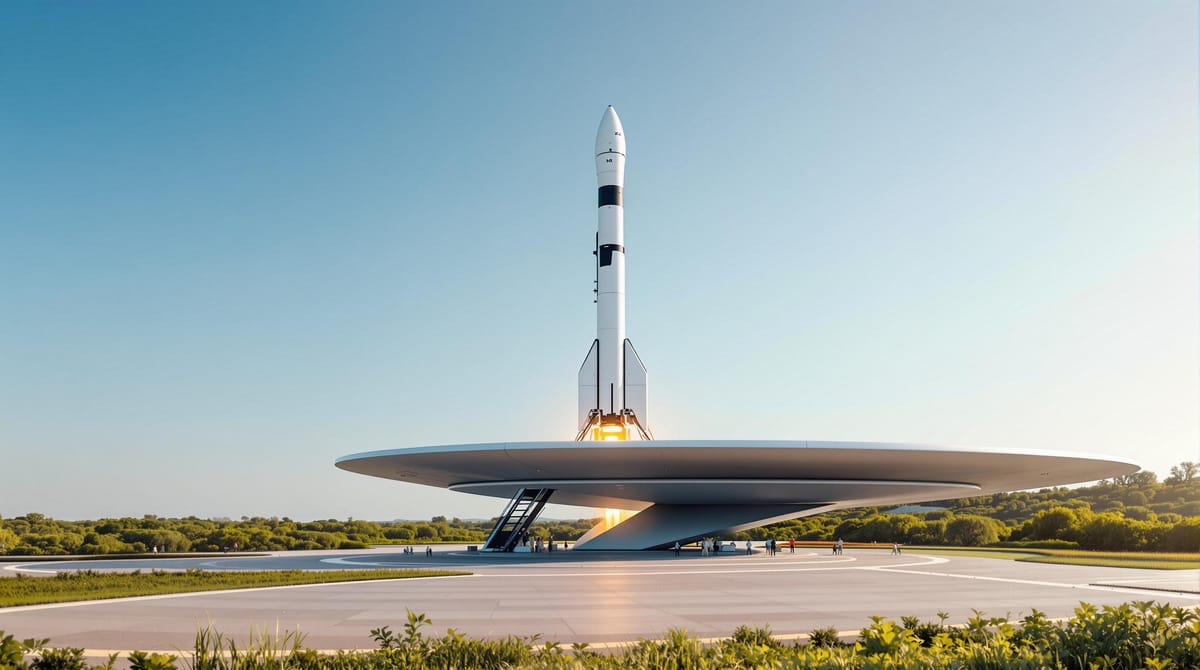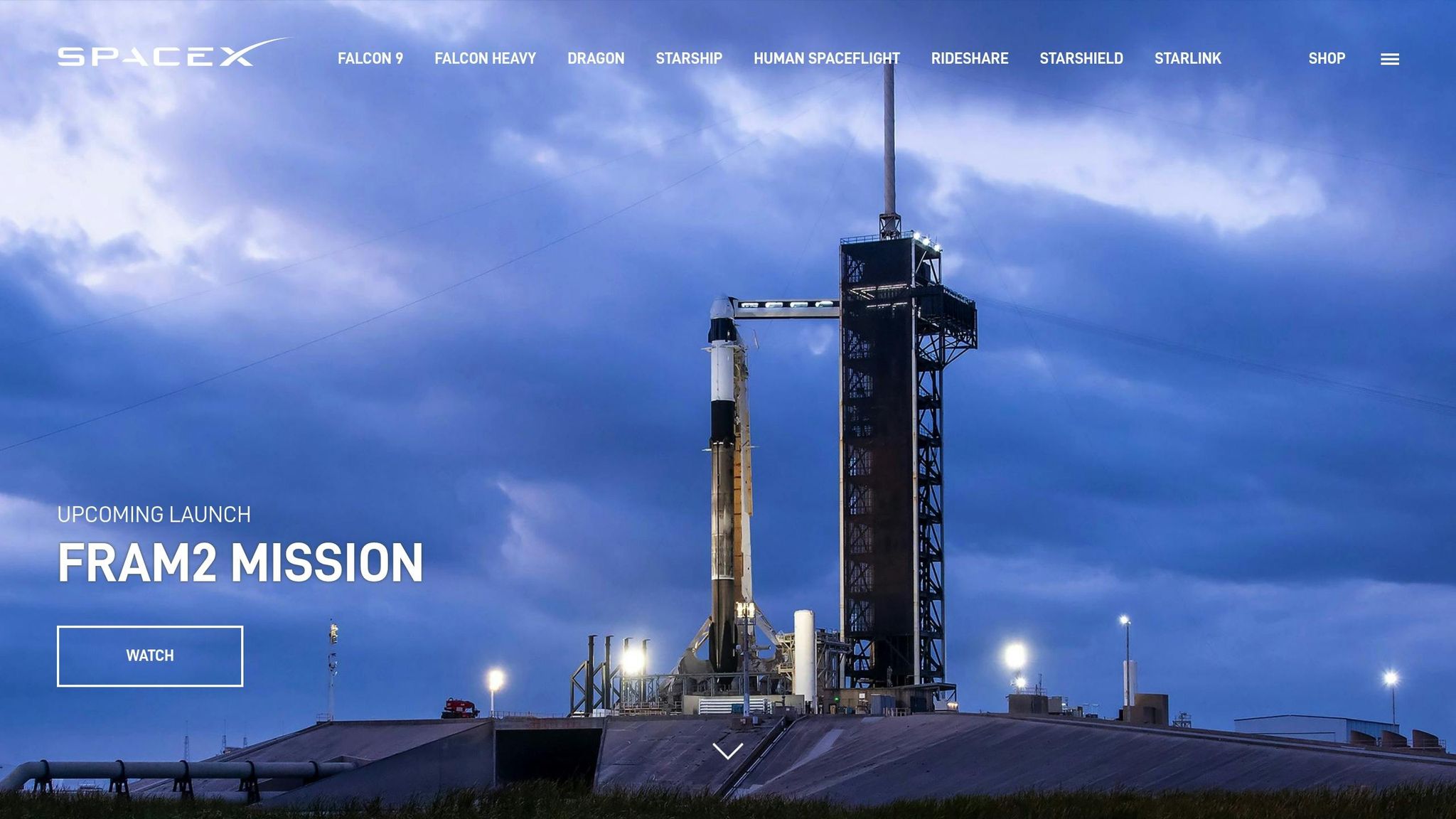SpaceX Landing Systems: Key Innovations
Explore how innovative landing systems are transforming space travel by enabling reusable rockets, reducing costs, and enhancing mission capabilities.

SpaceX has revolutionized space travel by creating reusable rocket landing systems. Here's how they do it:
- Propulsive Landings: Rockets use controlled engine thrust for vertical landings, guided by Merlin engines, grid fins for steering, and landing legs for stability.
- Autonomous Navigation: Advanced sensors like GPS, radar altimeters, and real-time algorithms enable precise, self-guided landings.
- Ocean Platforms: Autonomous droneships recover rockets at sea when ground landings aren't possible, achieving milestones like the first successful ocean landing in 2016.
Why It Matters:
- Cost Savings: Reusing rockets drastically reduces launch costs.
- Market Growth: Lower costs make space accessible to more businesses.
- Future Goals: SpaceX is improving landing precision, reusability speed, and materials for Moon and Mars missions.
These advancements set a new standard for efficiency and affordability in space exploration.
How SpaceX Lands Rockets with Astonishing Accuracy

Propulsive Landing Systems
SpaceX's propulsive landing system uses controlled engine thrust to achieve safe, vertical landings.
How Propulsive Landing Works
This landing process involves three key phases:
- Boostback Burn: Engines fire in reverse after stage separation to adjust the rocket's trajectory.
- Entry Burn: Engines ignite during reentry to slow the rocket down.
- Landing Burn: Engines fine-tune the descent for a smooth and controlled touchdown.
Key Components of the System
The propulsive landing system depends on three main components:
| Component | Role |
|---|---|
| Merlin Engines | Deliver controlled thrust for descent |
| Grid Fins | Help steer the rocket with aerodynamic precision |
| Landing Legs | Ensure stability during touchdown |
Each part plays a critical role. The engines manage thrust levels, the grid fins guide the rocket's path, and the landing legs provide a stable base for landing.
Why Propulsive Landing Matters
Precise thrust adjustments make it possible to recover rockets reliably and with great accuracy. This precision is a cornerstone of SpaceX's advanced navigation and control systems.
Navigation and Control
SpaceX achieves precise rocket landings using advanced navigation and control systems that guide the rockets back to Earth autonomously. These systems combine sensors and real-time algorithms to manage the complex task of controlling space vehicles. Below, we break down how sensor-driven guidance and in-flight adjustments make this possible.
Self-Guided Systems
SpaceX relies on a combination of sensors to determine the rocket's position and orientation during landing. Key components include:
- GPS units for tracking position
- Inertial measurement units (IMUs) for detecting motion
- Computer vision for recognizing landing targets
- Radar altimeters for measuring altitude
By combining data from these sensors, the system builds redundancy, ensuring reliability even if one sensor fails. This integration, known as sensor fusion, forms the backbone of the control system, enabling accurate navigation and setting the stage for precise flight corrections.
In-Flight Adjustments
Using the data from its sensors, the flight computer makes real-time adjustments during descent. It processes this data to fine-tune the rocket’s trajectory, account for environmental factors, and align with the moving landing platform. These automatic corrections ensure the rocket remains on course despite unexpected conditions.
Continuous upgrades to these systems improve their ability to handle operational and environmental challenges. These real-time adjustments, combined with SpaceX's propulsive landing techniques, highlight the company's thorough approach to safe and consistent rocket recoveries.
Ocean Landing Platforms
SpaceX has revolutionized rocket recovery with its autonomous spaceport droneships, designed for missions where returning to the launch site isn't an option. These platforms rely on precise in-flight adjustments and advanced sensor technology to ensure successful landings in the ocean.
Major Landing Milestones
SpaceX's progress in ocean landings is reflected in several key achievements:
| Date | Achievement | Platform |
|---|---|---|
| April 8, 2016 | First successful droneship landing | Of Course I Still Love You |
| June 3, 2017 | First reused booster ocean landing | Just Read the Instructions |
| January 31, 2022 | 100th successful droneship landing | A Shortfall of Gravitas |
These milestones highlight SpaceX's advancements in autonomous landing systems and their role in making rocket reuse a reality.
Business and Technical Results
SpaceX's technical advancements have led to impressive economic and operational outcomes. Its landing systems have reshaped the economics of launches by enabling reusable boosters, setting a new benchmark for the industry.
Cost Savings with Reusability
Reusing boosters spreads out production and refurbishment costs across multiple launches, significantly reducing per-launch expenses. This approach has changed how space missions are financed, making them much more affordable.
Impact on the Commercial Space Sector
Lowering launch costs has opened the door for broader access to space, drawing in a variety of clients and fueling market growth. The dependable and efficient autonomous landing systems have increased the frequency of flights, creating fresh opportunities for businesses in the commercial space industry.
What's Next for SpaceX?
SpaceX is pushing forward with its landing system advancements by focusing on:
- Better Precision Landing: Adding advanced sensors and refining algorithms to improve landing accuracy.
- Faster Reusability: Simplifying maintenance and introducing automated inspection systems to speed up turnaround times.
- Stronger Materials: Developing heat-resistant materials to extend the lifespan of boosters.
These upgrades aim to enhance current systems, boost efficiency, and keep SpaceX at the forefront of the space industry.
Conclusion
SpaceX's landing systems have reshaped spaceflight by making reusable rockets a reality. These systems set new benchmarks for reducing costs and improving turnaround times, proving how reusable orbital-class rockets can transform the industry.
By cutting launch expenses and broadening mission options, these advancements open doors to more ambitious exploration. Ongoing improvements in accuracy, reusability, and materials pave the way for future missions to the Moon and Mars, keeping SpaceX ahead in the global space race.
Check out our SpaceX Stock Investment Guide for more on how these breakthroughs impact market trends.
SpaceX Stock Investment Guide
The SpaceX Stock Investment Guide translates the company's advancements into practical insights for investors, focusing on how its landing systems impact valuation and market trends.
The guide explains how SpaceX's landing system achievements influence its value, market growth, and investor confidence. These technical milestones play a key role in shaping market sentiment and long-term investment potential.
| Investment Factor | Impact on Valuation |
|---|---|
| Launch Success and Landings | Builds investor trust and supports market expansion |
| Funding Rounds | Reflects market trends and helps identify investment timing |
| Technological Advancements | Boosts long-term value and strengthens competitive edge |
The guide also covers pre-IPO strategies, examines funding rounds tied to launch milestones, and analyzes market trends influenced by SpaceX's innovations.
Through the Investor Club, members receive exclusive updates on how SpaceX's landing technology affects private market valuations. Educational tools help investors connect the dots between these advancements and strategic investment opportunities.
For more details on investing in SpaceX and understanding how its landing systems contribute to market value, visit SpaceX Stock Investment Guide.
Comments ()